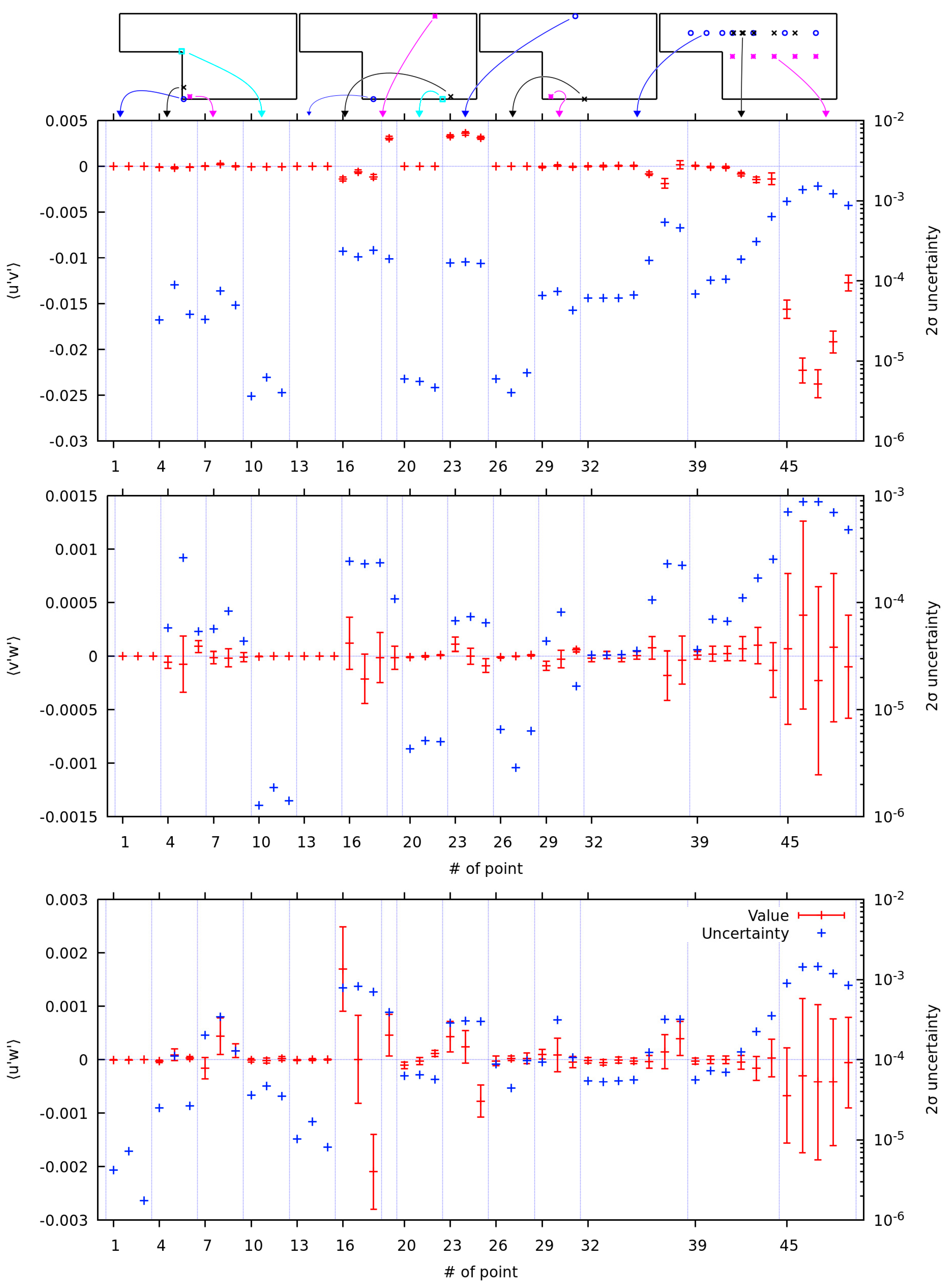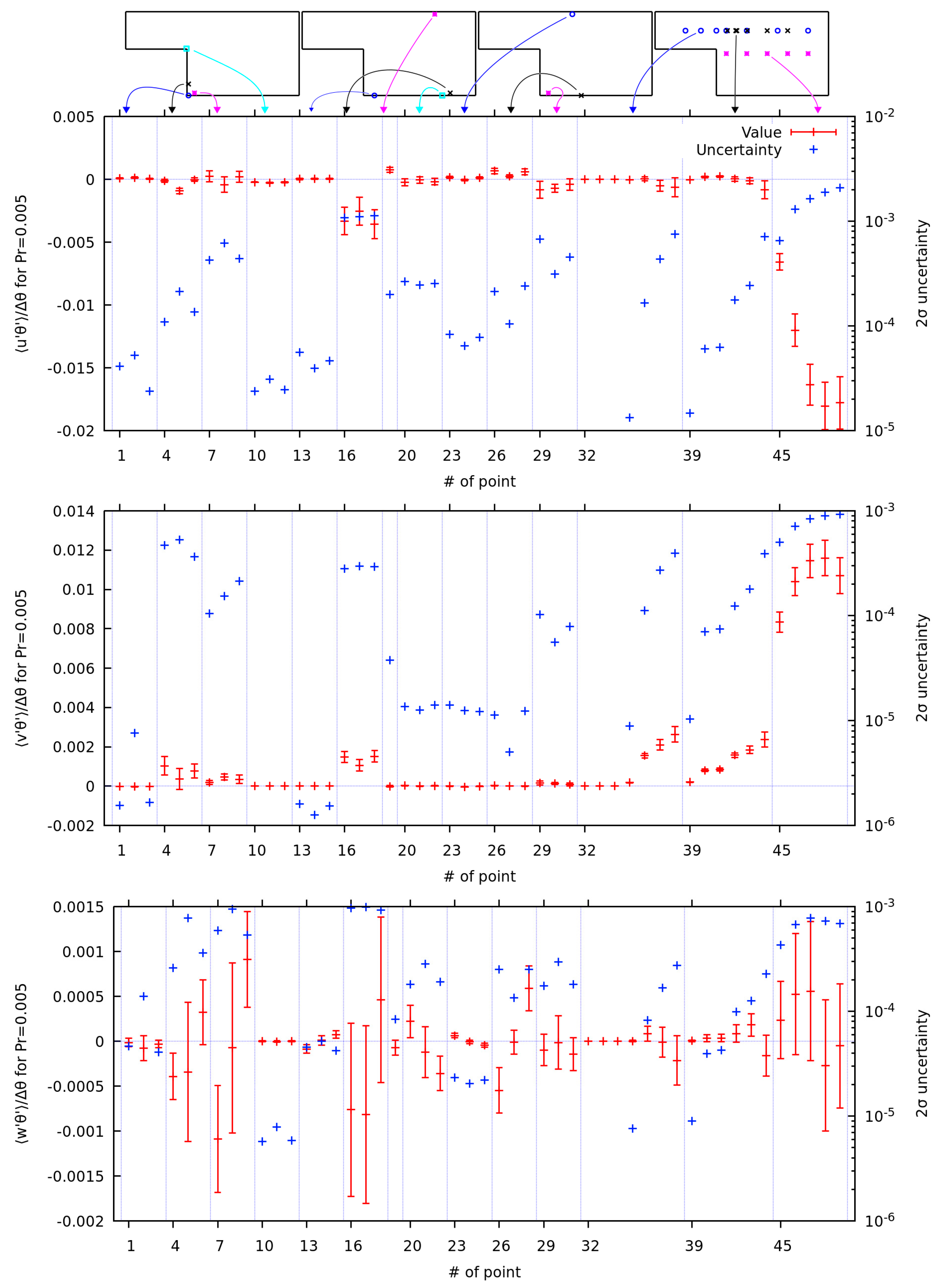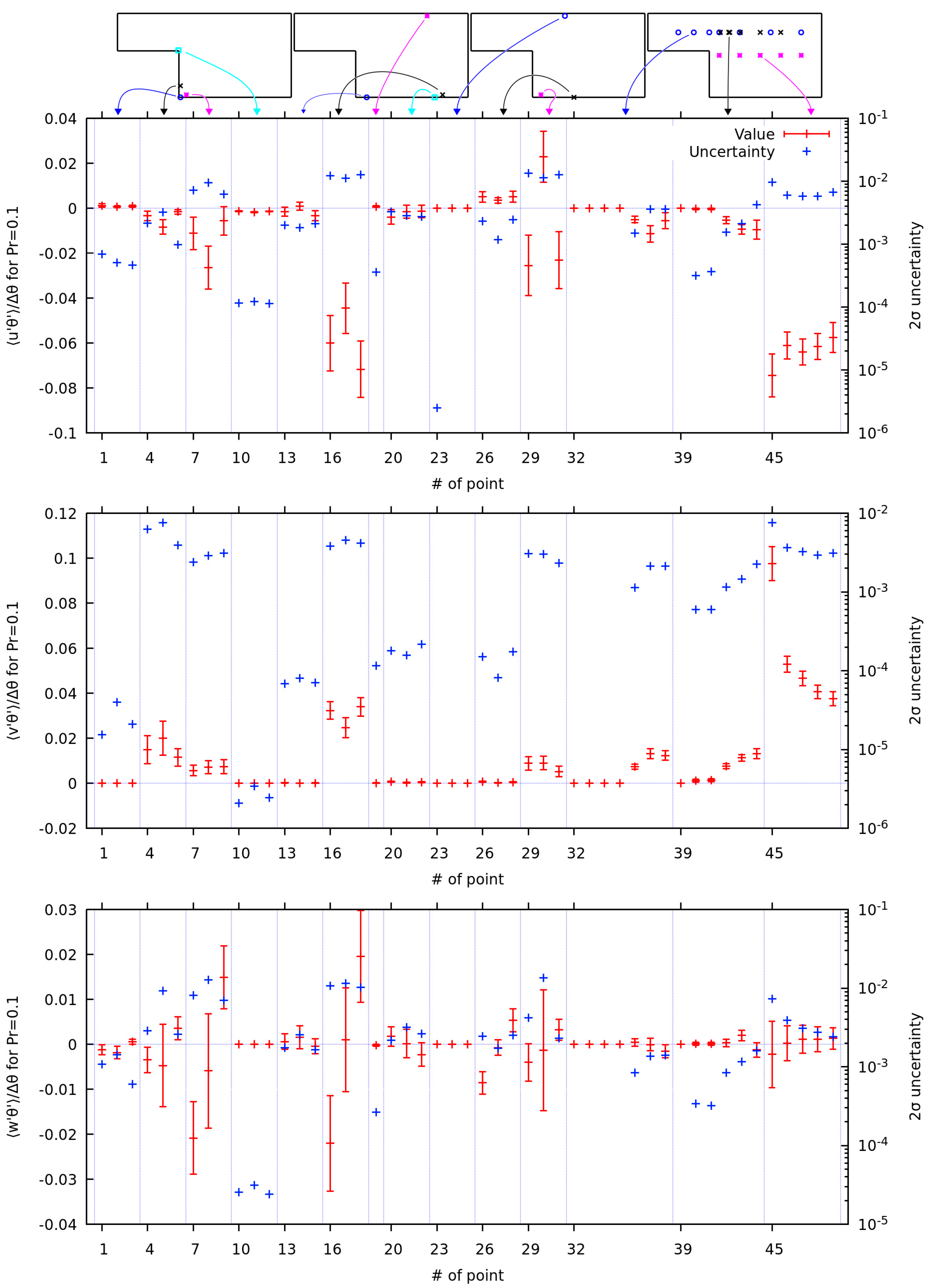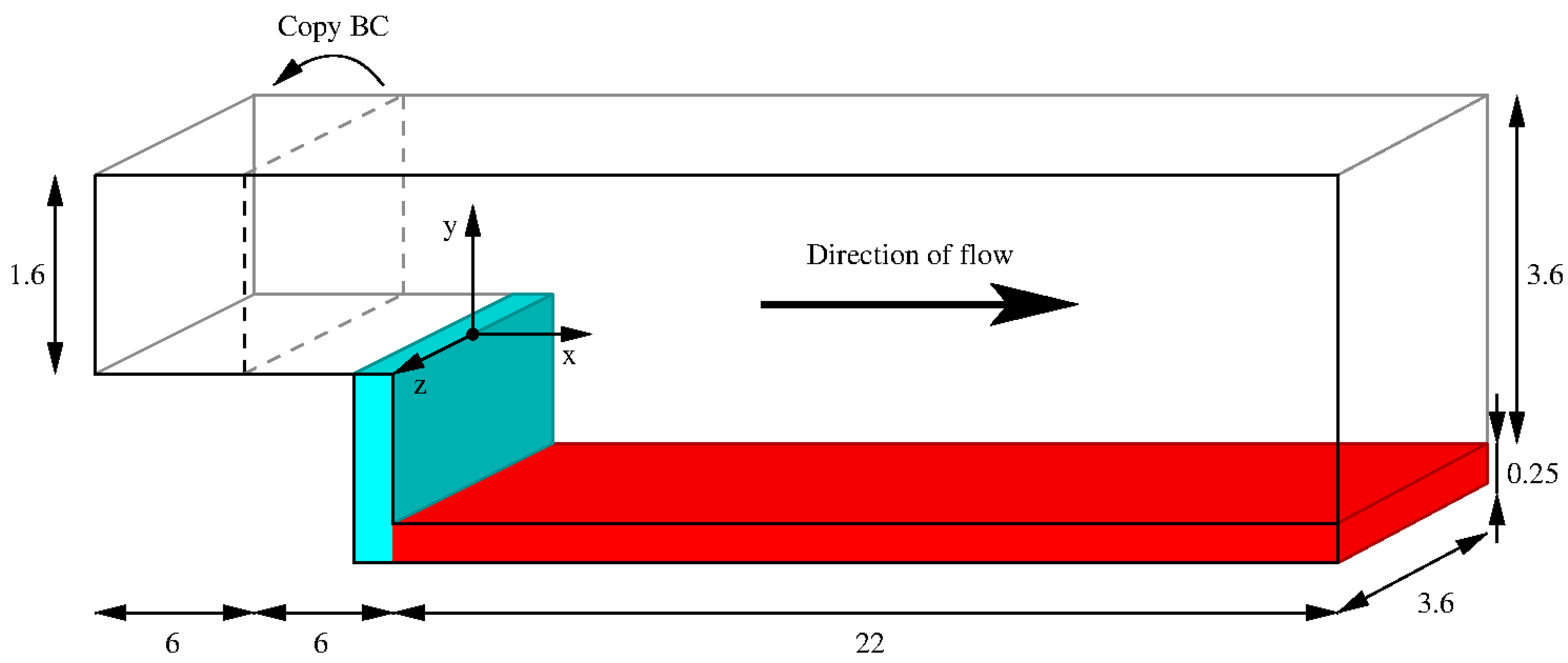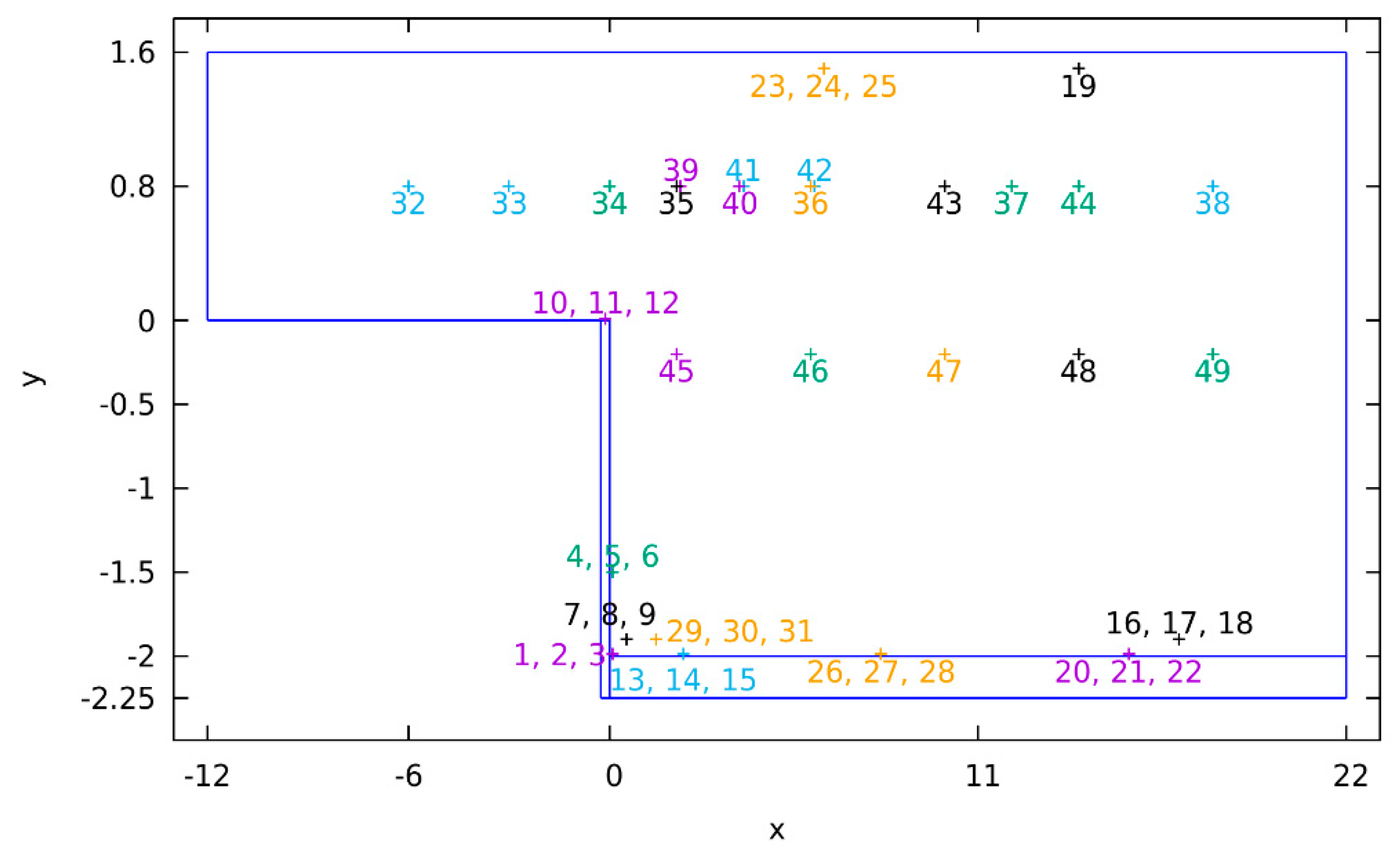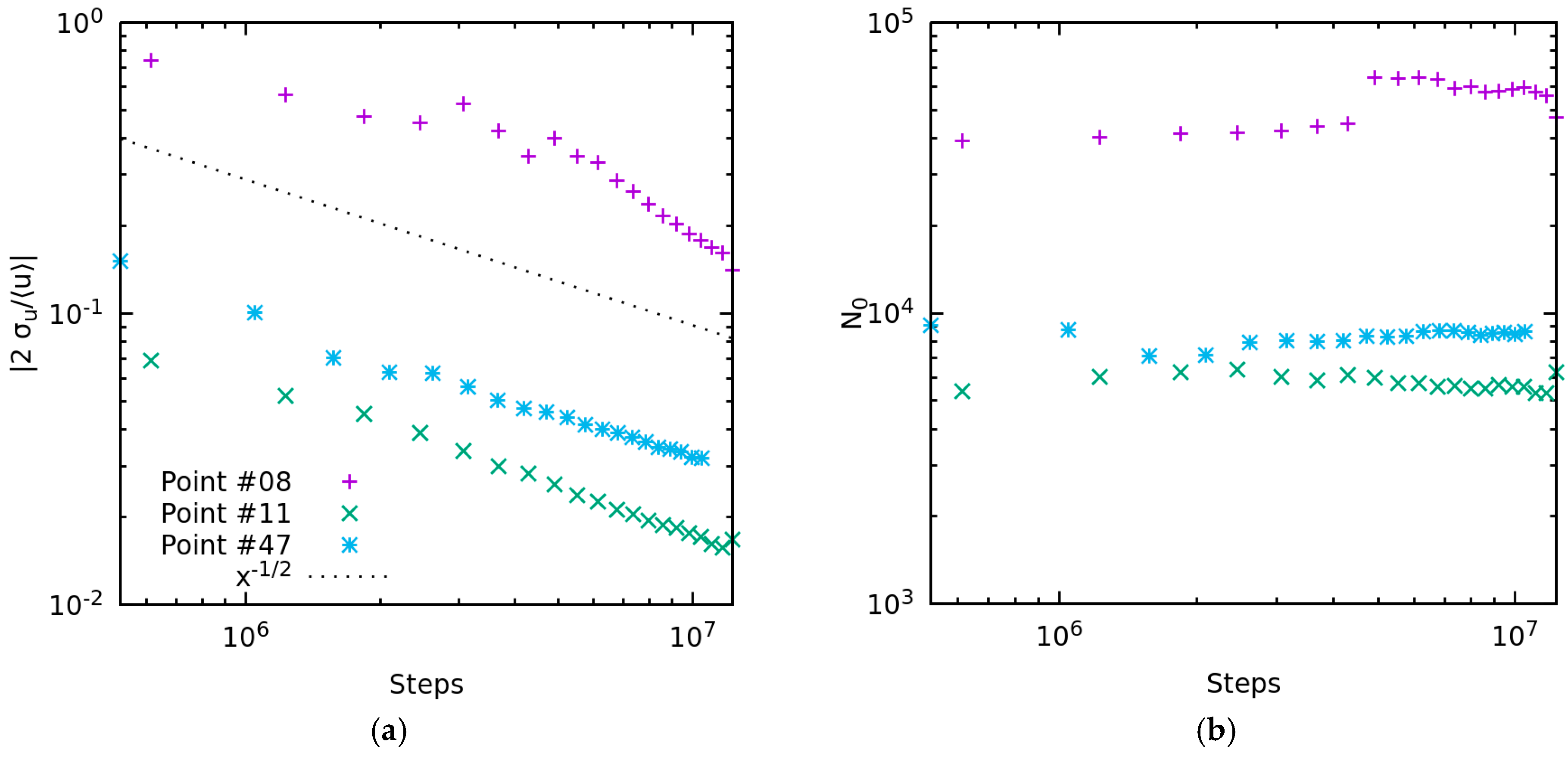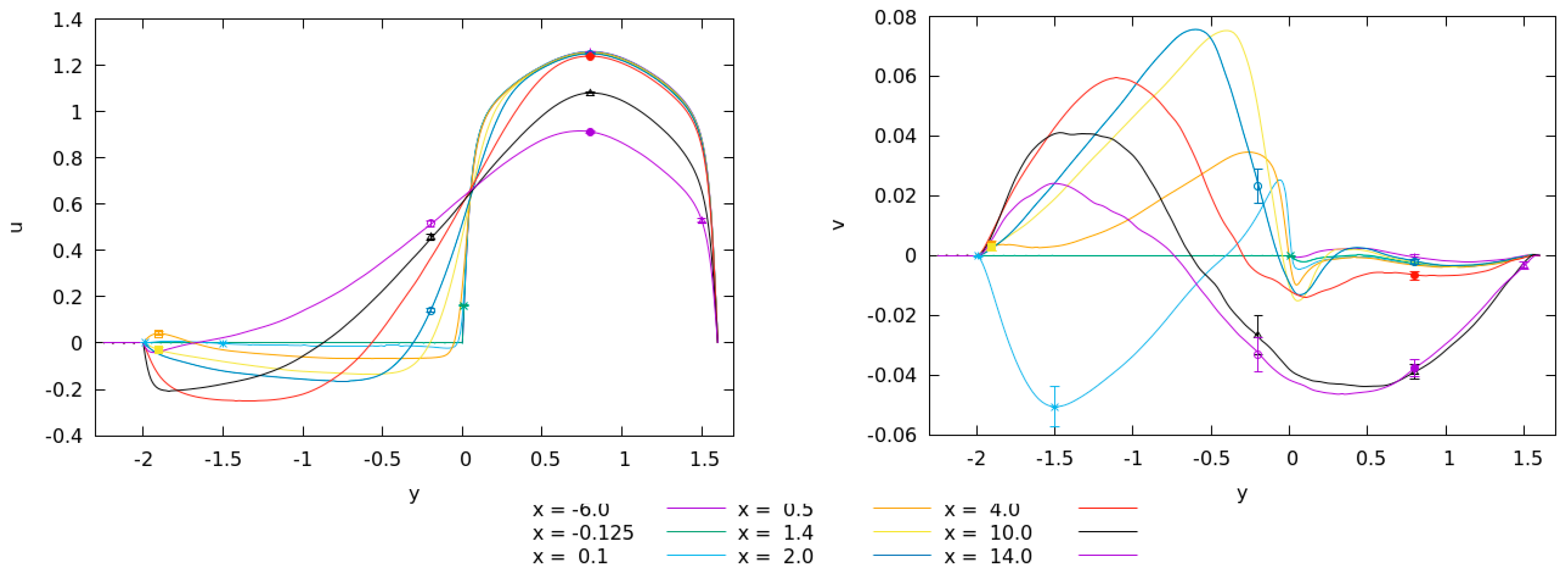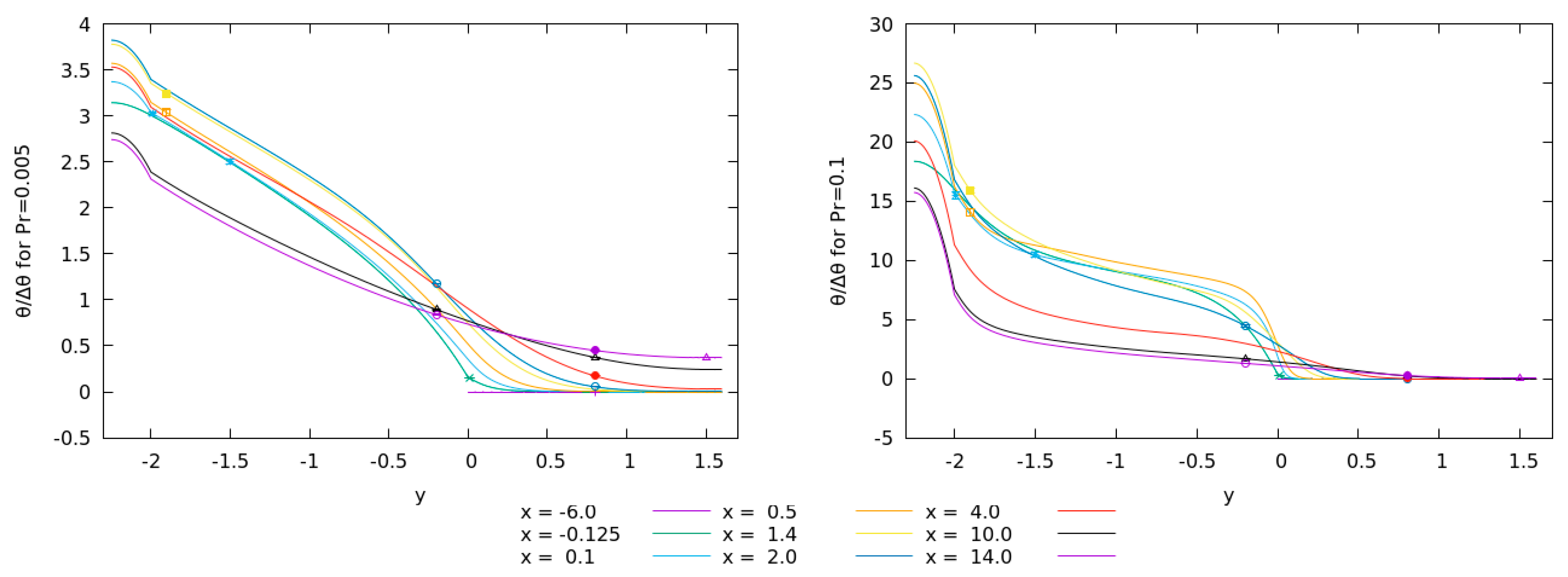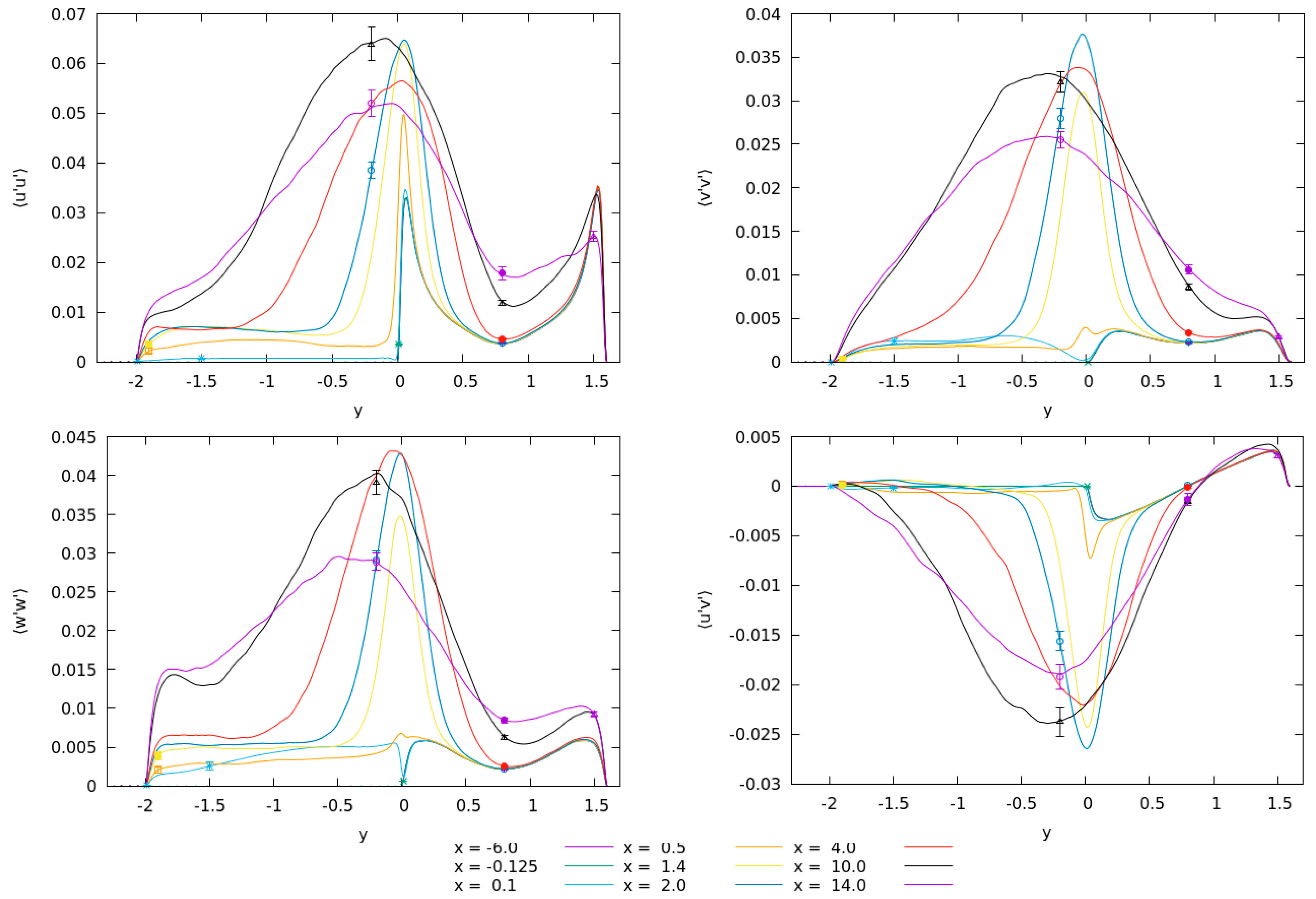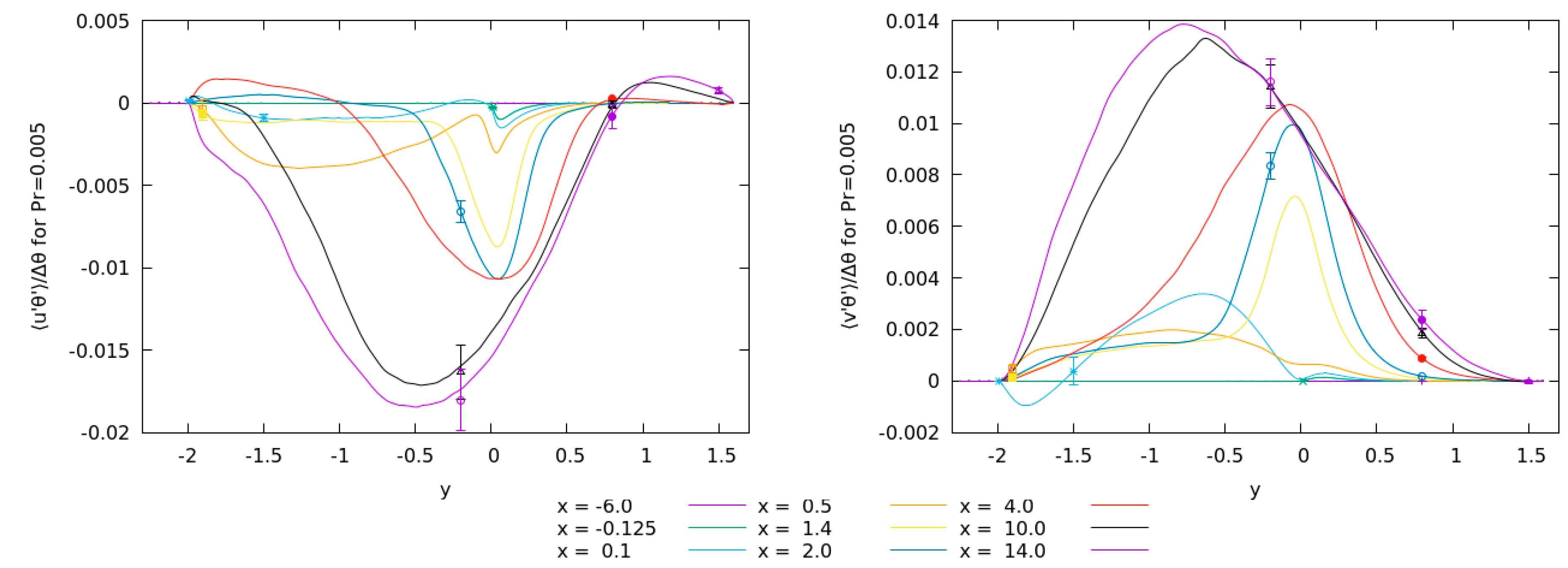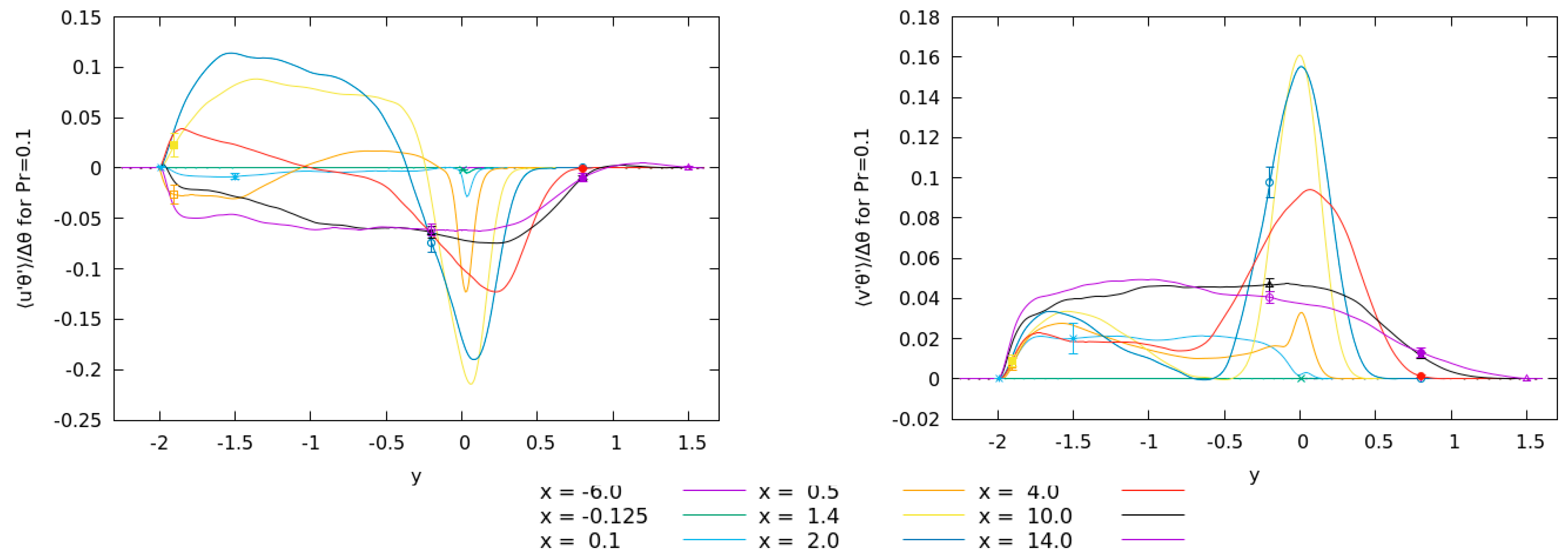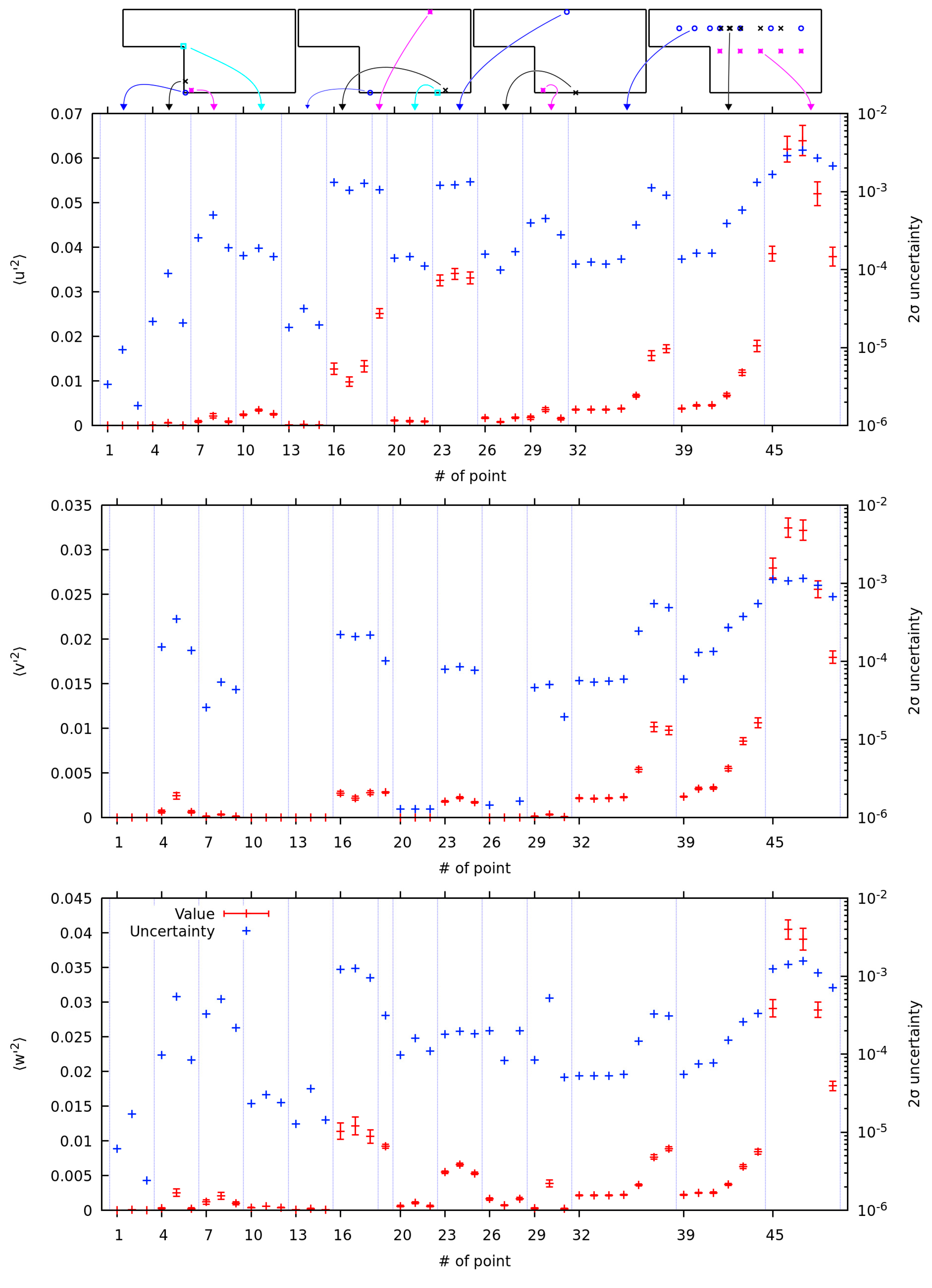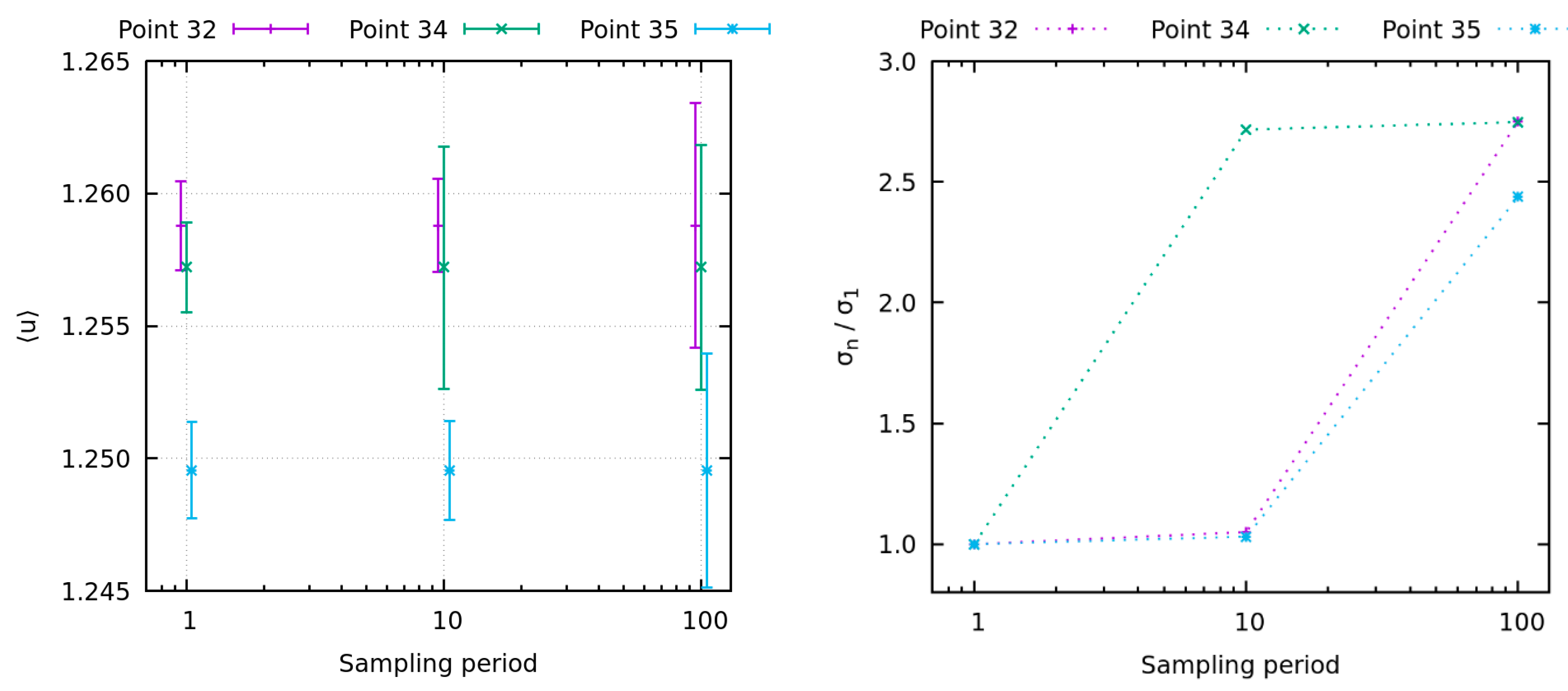Here we present the results in all the 49 monitor points that were used during the DNS of BFS. The data from the first 31 monitor points were averaged over 12 million time steps for the velocity, pressure and the passive scalar with
. Samples from monitor points 32 to 49 were averaged only over about 10 million time steps. The data for the second passive scalar, with
were averaged over 7 million time steps. These discrepancies are because of late addition of monitor points 32 to 49 to the simulation, and late addition of the second passive scalar, which also had to reach a statistical steady state. Note that the averaging intervals differ in beginning only, but have identical end of time integration. The detailed integration span for uncertainty estimation is given in
Table 1.
Nevertheless, the profile data were obtained by integrating for the whole duration of 12 million time steps for velocity, pressure and passive scalar with . Therefore the uncertainty estimation for monitor points 32–49 is a conservative estimate for uncertainties of the profiles. The profiles involving passive scalar with were obtained from the same time span as uncertainty data.
The flow through time in the BFS case was approximately 60 dimensionless time units. With a time step of dimensionless time units, this is equal to approximately 150 thousand time steps. Thus, our simulation spanned more than about 80 flow-through times.
This is also confirmed in the simulation and can be observed in
Figure 4, where the convergence of relative
uncertainty for the streamwise velocity component with number of steps is shown. The figure was produced by calculating the average and the uncertainty approximately every
time steps. However, not every time sample was used in the calculation. The data set was down sampled to include every tenth time step. As we show later, this does not have a significant effect on the estimation of uncertainty. The figure also shows convergence of the decorrelation time
, or rather the number of time steps
associated with it.
3.2.1. Uncertainties in Profiles of BFS Results
The uncertainties in monitor points can be overlaid with the profiles that were presented in [
1]. The monitor point data cannot be extended to an arbitrary position in space, however, the profile data can be interpolated to the position of the monitor point. In our case, this interpolation was performed in the spectral space. First, we identify the relevant elements in the domain in which the interpolated results are desired. Then, within the elements, which are relevant, the solution in collocation points is transformed into the factors of spectral modes. The appropriate one-dimensional base functions in case of nek5000 are
, where
is a Legendre polynomial of order
. Note that this is not connected with the PN/PN-2 formulation, where the polynomials used for pressure are actually of lower order. The range of the polynomials is limited to the interval [−1,1]. Appropriate translation and scaling has to be performed to obtain the results at the desired location within the element. Since we are using 7 collocation points per direction in each element, the maximal order of base function polynomial is 6. The interpolated data are obtained by evaluating the base function at the desired location within the element and multiplying by appropriate spectral mode factor.
To obtain the appropriate line profile, two coordinates of the monitor point are taken as the desired location of the line profile. The positions along the line are the same as the positions of collocation points in this direction.
The estimation of statistical uncertainties allows us to put error bars on the results of a DNS. The following figures try to demonstrate the uncertainties within the results in profiles. Since in the DNS we are usually concerned with other sources of uncertainty it might be unusual to see significant error bars which originate only from statistical sources.
Figure 5 shows the profile lines of average velocity components together with values and
uncertainties obtained in the relevant monitor points. The profiles are limited to the plane
, where most of the monitor points lie. However, due to brevity, only some profiles along with appropriate monitor points in this plane are shown. At
, the heater is present and all velocity values are zero there. For profile
, the region below
is located inside the step wall and that is why the velocity values are equal to zero.
From the figure it is apparent that the streamwise velocity component is well converged, since the uncertainties are almost invisible. However, for the velocity component the uncertainties are relatively significant. Also, location significantly influences the uncertainties, if we compare uncertainties at and . The component of velocity is the least interesting and is not shown in figure. Although there is a weak flow through the plane immediately after the step (), with the added uncertainties it is clear that it is not statistically significant, as is expected due to the symmetry. The average values fall within uncertainty of zero.
Figure 6 shows the profiles of both passive scalars together with the averages and uncertainties calculated in the monitor points. Here, for the locations at
the fields are not zero, since the thermal field penetrates into the walls and heater. Similar is true for the location at
and values with
. The uncertainties in the scalar fields are relatively small, which we attribute to high diffusion due to low Prandtl number.
Figure 7 shows the diagonal and non-diagonal components of the Reynolds stress tensor that are expected to be different from zero in the plane
together with the monitor point data. Some discrepancy between profile and monitor point data can be observed. This is due to data from these particular monitor point was only averaged over around 10 million time steps, while the profile was averaged over 12 million time steps. This is the case for profile of
at
and monitor point 47 at
.
The averages seem adequately converged and the anisotropy of turbulence immediately after the step is clearly observable (compare profile of fluctuations at , where fluctuations in direction are almost twice the fluctuations in direction). However, this turbulent anisotropy persists towards the outflow (profile and monitor points at and ). The data from monitor points support the claim that the anisotropy is statistically significant. Of course, the anisotropy of turbulence can also be observed near the walls.
The only non-diagonal component of the Reynolds stress tensor that is non-zero through the plane is the . At monitor point 48 with and a similar discrepancy can be observed between the profile and the monitor data due to difference in the integration time.
Figure 8 shows the fluctuations of temperature through the middle of the BFS domain. The points located in the stagnation zones and close to the heater exhibit rather high uncertainties in the fluctuations. This is especially apparent in the case of lower Prandtl number. However, our analysis showed that the significant increase of the uncertainties in these regions is more connected to the length of decorrelation time, than to amplitude of oscillations. If we observe the history of temperature fluctuations in various points, it is apparent that at different monitor points the temperature oscillates at different timescales or frequencies. The smoother temperature signals have higher decorrelation times and thus higher uncertainties.
Figure 9 shows the profile of turbulent heat flux components for the passive scalar with
through the plane
. The
and
components of turbulent flux are increasing towards the outflow. The third component is zero within the statistical uncertainty and is not shown.
Figure 10 shows the profile of turbulent heat flux for passive scalar with
together with values and uncertainties calculated in the monitor points in the plane
. The
and
components of turbulent heat flux for both Prandtl numbers show that higher uncertainties are found where the average values are higher (unlike with temperature fluctuations above). However, a general observation is that the relative uncertainties in the recirculation zone are a bit higher than outside of it. This is visible with comparison of turbulent heat flux results with similar values, such as
component for
at points 5 (
,
, cyan) and 35 (
,
, blue) or 41 (
,
= 0.8, red), or component
with
at points 5 (
,
, cyan) and 43 (
,
, black) or 44 (
,
= 0.8, magenta).
3.2.2. Uncertainties in Monitor Points
Figure 11 shows the average velocity components, together with the
uncertainties, which correspond to roughly 95% confidence interval. The top row shows the approximate position of the appropriate points. This is just a guide for the eye, since point designations are not so informative. The streamwise velocity component shows decent convergence. The relative uncertainty in the average
velocity component seems to be larger, however, this is only because the absolute values of the velocity component are much lower. The absolute uncertainty is actually lower. A similar observation can be made about the
velocity component.
The streamwise velocity component in
Figure 11 is mostly positive. Note, however, the points 29 to 31. Since the component changes the sign in these three points, they are located near the stagnation zone. Similarly, the points 20 to 22 lie in a stagnation zone, where the streamwise velocity is close to zero. However, this component has larger absolute value at points 16 to 18 located downstream of the recirculation region and 26 to 28 located in the recirculation region.
The
velocity component at points 16 to 18, 29 to 31, and to a degree in 26 to 28 confirms the structure observed and discussed in [
1], where the flow is directed towards the heater at the edges (of
axis) but is directed away from the heater in the middle (around
). Also of note is that the velocity component immediately downstream of the step, at points 4 to 6 is directed towards the heater while, for example at point 45, it is directed away from the heater.
Note that values for streamwise and velocity components should be symmetrical over the plane , while the values for the velocity component should be anti-symmetrical, with values in the plane being zero. In fact, such a test can be performed for all the variables shown. Out of 350 such tests that we could perform, 12 tests failed, or around 3.4%. With the above 95% confidence interval, we would expect the failure rate to be around 5%. If such a test is performed with uncertainty, only one test fails. At monitor point 43, the component of turbulent heat flux for passive scalar with is within of zero; however, outside of range. For interval, the confidence interval is around 99.7% and we would expect one test to fail.
The component of velocity shows the anti-symmetries over the axis. However, interestingly, the points in the recirculation region have considerably larger uncertainties at than at the sides of the domain. This would indicate the flow is fluctuating over this plane, while being more steady at the sides. The only exception seems to be the points 26 to 28 which lie in the recirculation bubble.
Figure 12 shows the diagonal components of Reynolds stress tensor. The uncertainties are comparable between different components, however, the asymmetry of turbulence is still apparent (this is apparent just by observing the scale on the left). The asymmetry can also be found in the statistical uncertainties in the recirculation zone. The turbulent kinetic energy seems to be highest through the middle of the domain. However, there are some exceptions. These are at points 26 to 28, located upstream of the reattachment zone, and at points 16 to 18, located downstream of the reattachment zone. This differs from the reattachment zone, located around points 20 to 22. The peak in fluctuations is found around
. This is a peculiar result since the flow seems to be more turbulent closer to the lateral walls; however, this is due to the three dimensional structure of the flow. That is, the reattachment does not have a shape of a straight line but is prolonged towards the outflow closer to the lateral walls.
Figure 13 shows the average value, as well as the square of RMS fluctuations for the passive scalar with
. The average values have some expected properties: they are higher near the heater and downstream of the step. The drop in temperature through the points 45 to 49 may be surprising; however, fluid from the recirculation zone is heating fluid at points 32 to 38 and 39 to 44. According to the structure of the flow, described in [
1] the cold fluid is flowing towards the heater at the sides (
).
More interesting are the fluctuations of the passive scalar. Immediately one can notice the relatively high uncertainties in fluctuations in points located close to the heater. Unfortunately, no monitor point was placed in the heater to see the behaviour of uncertainties of thermal fluctuations in the solid. Consistently, thermal fluctuations in monitor points located inside or near the recirculation zone show higher statistical uncertainties, compared to thermal fluctuations in monitor points outside of recirculation zone.
Figure 14 shows the similar graph for the passive scalar with
. Note that the averaging time here is shorter so we expect slightly higher relative uncertainties. This is the case in the figure, however, we can observe the same trend of uncertainties of thermal fluctuations being higher at the points near the heater. Nevertheless, there are subtle differences, which would indicate that the influence of solid walls in connection with the Prandtl number is stronger than the proximity to the stagnation zones. These differences can be seen in first 6 monitor points 13 to 15, as well as 29 to 31. However, since the lower Prandtl number means wider thermal layer a wider influence of stagnation zones could be observed.
The higher uncertainties in thermal fluctuations, as well as in average values of passive scalars, were traced back to an order of magnitude higher decorrelation times. By Equation (3) this increases the statistical uncertainties. The higher decorrelation time is estimated since the temperature oscillations have longer periods, although the amplitudes of the fluctuations do not seem to be vastly different.
The uncertainties of Reynolds stresses and turbulent heat fluxes can be found in the
Appendix A.
Graphs in
Figure 11,
Figure 12,
Figure 13 and
Figure 14 were produced by taking into account monitor data at every time step. An interesting observation can be made if we skip some of the time steps in the calculation of averages. Our time step length was approximately 0.1 of the time step calculated through the Courant–Friedrichs–Lewy condition (CFL time step). We found that the average results do not change by much if values from every hundredth time step (or every tenth CFL time step) are taken. Nevertheless, the uncertainties of these averages can differ by up to a single-digit factor. This results from the different estimation of the decorrelation time
.
It should also be noted that by taking every time step data, the order of the auto-regression model has to be set to very high values to properly estimate the decorrelation time. The order for two variables at point 8 was as high as the maximal order we used, which is around 65,000. For around 8 other variables and points, the estimated order was above 60,000. This increases the demands for memory considerably and slows down the statistical analysis. If the maximal order of the auto-regression model was set to the default value of 512, the results significantly diverged from the proper results and from results where only every tenth or hundredth time step is used for estimation. In the latter two cases the increase of the maximal order of the auto-regression model does not need to be so drastic, since the number of parameters needed to properly determine the autocorrelation function also decreases with down sampling. Our simulation is, therefore, considerably oversampled for determination of the statistical variables with the arsel library.
With all of the above, our conclusion is that the frequency of monitoring data can safely be reduced. Nevertheless, the data from the channel flows suggest that the period of sampling should not pass over 10 CFL time step as there the results start to differ significantly. A similar effect is observed in the BFS flow and is shown in
Figure 15 for three points. Although other variables and other monitor points also show some changes, we selected the streamwise velocity component and in points where the changes are among the greatest. Note, however, that the average value itself changed insignificantly. The only change is in the estimated uncertainty of the averages.
